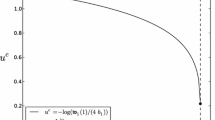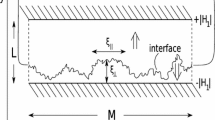Abstract
We continue our analysis of the phase diagram of a discrete random surface, with no “downward fingers,” lying above a flat two-dimensional substrate. The surface is closely related to the 2D Ising model and its free energy is exactly solvable in much (but not all) of the phase diagram. There is a transition at temperatureT w from a high-T infinite height or wet phase to a low-T finite height or partially wet phase. Previously it was shown that when a parameterb, related to the contact interaction, is positive,T w is independent ofb and there is a logarithmic specific heat divergence asT w is approached fromeither side. Here we show that forb<0,T w does depend onb and there isno thermodynamic singularity from the wet phase. The partially wet phases forb⩽0 andb>0 differ in the absence or presence of a monolayer covering the entire substrate; this results in a first-order transition across the lineb=0,T<T w.
Similar content being viewed by others
References
D. B. Abraham and C. M. Newman,Phys. Rev. Lett. 61:1969 (1988).
D. B. Abraham and C. M. Newman,Commun. Math. Phys. 125:181 (1989).
H. W. Diehl, inPhase Transitions and Critical Phenomena, Vol. 10, C. Domb and J. L. Lebowitz, eds. (Academic Press, New York, 1986).
D. S. Fisher and M. E. Fisher,Phys. Rev. 25:3192 (1982).
M. E. Fisher,J. Stat. Phys. 34:667 (1984).
J. K. Percus,Commun. Math. Phys. 40:283 (1975).
H. van Beijeren,Commun. Math. Phys. 40:1 (1975).
A. Coniglio, C. R. Nappi, F. Peruggi, and L. Russo,Commun. Math. Phys. 51:315 (1976).
K. Jogdeo,Ann. Stat. 6:232 (1978).
C. M. Fortuin, P. W. Kasteleyn, and J. Ginibre,Commun. Math. Phys. 22:89 (1971).
J. D. Esary, F. Proschan, and D. W. Walkup,Ann. Math. Stat. 38:1466 (1967).
J. L. Lebowitz,Phys. Rev. B 5:2538 (1972).
M. Aizenman, J. Bricmont, and J. L. Lebowitz,J. Stat. Phys. 49:859 (1987).
Y. Higuchi,Z. Wahr. 61:75 (1982).
H. Kesten,J. Stat. Phys. 25:717 (1981).
L. Russo,Z. Wahr. 56:229 (1981).
J. W. Essam, inPhase Transitions and Critical Phenomena, Vol. 2, C. Domb and M. S. Green, eds. (Academic Press, New York, 1972).
Author information
Authors and Affiliations
Additional information
This paper is dedicated to Jerry Percus.
Rights and permissions
About this article
Cite this article
Abraham, D.B., Newman, C.M. The wetting transition in a random surface model. J Stat Phys 63, 1097–1111 (1991). https://doi.org/10.1007/BF01030001
Received:
Issue Date:
DOI: https://doi.org/10.1007/BF01030001




